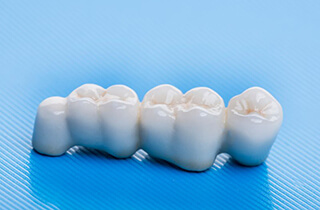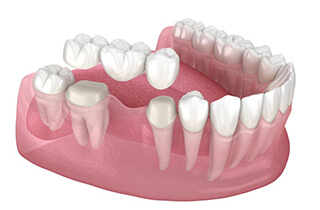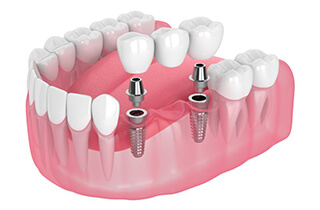Dental Bridges
Serving Dallas, Arlington, Mesquite, Grapevine & Fort Worth
While some people might be missing a tooth or two, others may have lost a few in a row, which can lead to multiple kinds of complications. The good news is that our team at Bear Creek Family Dentistry can provide dental bridges to replace several consecutive missing teeth. These restorations are natural-looking and durable, and they’re able to last for a decade or more so long as you take good care of them. Keep reading to learn more about dental bridges or give us a call today to schedule a consultation with our team!
What is a Dental Bridge?

This type of restoration is mainly reserved for patients who are missing one to three teeth in a row. Instead of relying on the gum line like dentures, dental bridges are designed to be supported via two dental crowns and pontics, or the artificial teeth that will connect the two sides. The materials used will be tooth-colored and durable, that way your restoration can function just like your natural pearly whites.
Types of Dental Bridges

During your consultation, our team will walk you through your options for bridging the gap in your smile. We’ll evaluate your oral health, go over your smile goals, and discuss the best solution that fits your unique needs. Here are the two kinds of dental bridges we offer:
Traditional Dental Bridge

Traditional dental bridges typically consist of two dental crowns that are linked by pontics to replace one to three missing teeth. Anymore than three and this can make the restoration less stable. Our team will alter the enamel of both adjacent teeth so that we can make room for your bridge.
Implant Bridge

Unlike traditional ones, implant dental bridges will not require us to reshape the enamel of your adjacent teeth. Instead, we’ll place titanium posts into your jawbone to serve as new tooth roots which will support your restoration. Not only can an implant bridge replace missing teeth, but it can also provide greater stability and longevity compared to a traditional one, and the metal posts will even be able to prevent jawbone deterioration.
The Benefits of Getting a Dental Bridge

Many of the advantages of renewing your smile with a dental bridge include:
- Improved oral health
- Natural-looking results
- Simplified maintenance
- Boosts self-esteem
- Preserves the jawbone with implant dental bridges
- Long-lasting solution (10+ years with traditional bridges; 30+ with implant bridges)
Dental Bridges FAQs
What Are Dental Bridges Made Of?
Dental bridges are typically made from strong, natural-looking materials designed to blend seamlessly with your smile. At Bear Creek Family Dentistry, we often use highly durable porcelain because it strikes a perfect balance between strength and aesthetics. With its naturally “wet” appearance and translucence, no one will ever suspect it’s not your real tooth.
However, the choice of material depends on your oral health, the bridge’s location, and your personal preferences. We’ll help you choose the best option to restore both function and beauty to your smile.
Is Getting a Dental Bridge Painful?
Despite appearances, most patients say they experience little to no pain when getting a dental bridge. At our practice, we use local anesthesia to numb the area during tooth preparation, so you’ll stay comfortable throughout the procedure.
Afterward, you might experience mild soreness or sensitivity around the treated area for a few days, but it shouldn’t be anything some over-the-counter pain relievers can’t handle.
Until you’re adjusted, we recommend soft foods to help ease the transition and prevent any sudden sharp pains from biting something hard. If any discomfort lingers, our team is just a call away, so don’t hesitate to reach out!
How Long Should a Dental Bridge Last?
With proper care, dental bridges typically last between five and fifteen years, sometimes even longer, depending on the type and your level of care. Implant bridges tend to last longer than their traditional counterparts, often staying strong for decades, if not a lifetime.
Regardless of which you choose, brush and floss daily, especially under the prosthetic. If you need to, try using a water flosser to get food particles and plaque that get left behind underneath.
Next, be sure to visit us twice a year to catch issues early. Lastly, avoid chewing on hard objects like ice or pens, and don’t use your teeth as tools to open packaging.
How Many Teeth Can a Dental Bridge Replace?
Dental bridges can replace one to four missing teeth in a row, depending on the situation. A standard bridge replaces one or two teeth, while more complex designs can span a larger gap if necessary.
However, the more teeth that are replaced, the less stable the overall prosthetic becomes. Implant-supported bridges offer greater stability, though they don’t completely eliminate the risk.
Your comfort, the function of your bite, and aesthetics are always our top priorities when creating your custom bridge. So, during your consultation with our team, we’ll examine your mouth and figure out how many teeth can be safely and effectively replaced.
